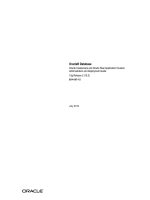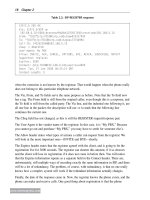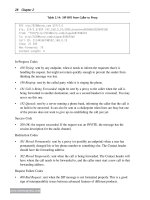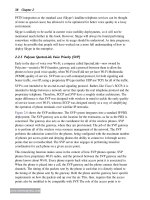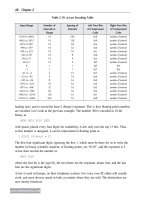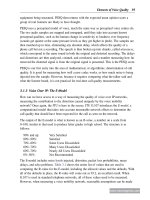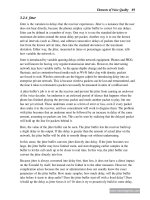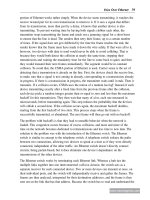Scalable voip mobility intedration and deployment- P17 pdf
Bạn đang xem bản rút gọn của tài liệu. Xem và tải ngay bản đầy đủ của tài liệu tại đây (223.7 KB, 10 trang )
160 Chapter 5
www.newnespress.com
0°180°
90°
-90°
16-QAM
quadrature axis (Q)
x x x
xx x x
x
xx x x
x x x x
0°180°
90°
-90°
64-QAM
quadrature axis (Q)
x x
x x
x x
x
x
x x
x x
x x
x
x
x x
x x
x x
x
x
x x
x x
x x
x
x xx xx x x x
x
x x
x x
x x
x
x
x x
x x
x x
x
x
x xxx x x x x
in-phase axis (I)
in-phase axis (I)
Figure 5.21: 16-QAM and 64-QAM
Introduction to Wi-Fi 161
www.newnespress.com
source bits and record whether that sum is even or odd as one additional bit. If one bit is
lost, the sum of the surviving bits can be compared in evenness to the sum bit, therefore
recovering the original data. This is called a parity check code, and conceptually introduces
the concept of using arithmetic on some or all of the source bits to produce the extra bits.
802.11ag uses a convolutional encoder to expand the source bits, in this case producing twice
the number of bits but, unlike the doubler, doing so more intelligently to avoid some loss
patterns of equal bit losses being worse than others. This expansion still produces only one
data rate, at a
1
2
-coding rate per modulation. To produce the other coding rates, 802.11ag just
uses the property that the error-correcting code can tolerate loss, and goes ahead and starts
tossing bits to get to a higher coding rate. This process, called puncturing, sounds inefficient
by reducing redundancy that was just added (why not just not add as many extra bits in the
first place?), but ends up saving on the complexity of the coding hardware, the radio.
The overall picture, then, for 802.11ag encoding is for the data bits to be scrambled (as with
802.11b), then expanded with the error-correcting code, then split among the subcarriers,
and then modulated.
Because of the larger number of things going on in the signal, there is more risk of losing
data if the receiver’s timing goes off a bit from the sender’s. To compensate, timing is
maintained by the addition of four pilot subcarriers. These carry a known signal pattern—
like the preamble—but do so for the length of the transmission. If the receiver’s clock
speeds up or slows down relative to the sender’s, then the constellation would essentially
rotate, and as the constellation points are now closer together than with 802.11b, the
rotation would cause the receiver’s bits to jumble. The pilot subcarriers’ known pattern lets
the receiver adjust as needed.
5.5.2.1 Preambles, Slots, and Optimizatoins
The preambles of 802.11ag are at 6Mbps, the lowest 802.11ag data rate. They are also
significantly shorter than the short 802.11b preambles: 40 microseconds for 802.11ag.
Improvements in signal processing technology since 802.11b came along allowed the
designers to not need to provide as much synchronization time.
Furthermore, the radios can stop receiving and start transmitting more quickly for 802.11ag
than they were expected to be able to do for 802.11b. This allows 802.11ag to use shorter
slots than 802.11b, allowing for less wasted time. For 802.11g, short slots are an option, and
are determined based on the presence of 802.11b clients, to prevent 802.11g clients from
using a different contention scheme. 802.11a always assumes the faster slots.
5.5.2.2 802.11b Protection
802.11a has no legacy clients to deal with. However, 802.11g is in the 2.4GHz band, and
has to avoid destroying 802.11b performance when the two devices are present together.
162 Chapter 5
www.newnespress.com
This destruction would occur because 802.11b radios use carrier detection (see Section
5.4.3) to determine whether the channel is clear before transmitting, and that means that the
802.11b devices are looking for 802.11b transmissions. 802.11g transmissions, however,
look nothing like 802.11b, and so 802.11b radios would end up only seeing 802.11g as
some sort of foreign interference.
To prevent this from disrupting any 802.11b device’s traffic, 802.11g introduces the notion
of CTS-to-self protection. Because 802.11b clients can only see 802.11b traffic, a way to
stop them from transmitting when an 802.11g transmission will start is for the 802.11g
device to send an 802.11b (legacy) CTS message first. This CTS message, sent not as a part
of an RTS/CTS transaction (see Section 5.4.6) but from the 802.11g sender to, nominally,
itself, sets the virtual carrier sense for all devices that can hear it. The CTS frame has a
Duration field—or the length of time to quiet the other stations—long enough to let it finish
the 802.11g transmission that will follow.
CTS-to-self protection is automatically turned on for any AP that has 802.11b legacy clients
associated to it, or for access points who overhear neighboring access points that have
802.11b clients assigned to them. This CTS-to-self message can be incredibly inefficient,
and has the potential to disrupt voice mobility networks, as will be mentioned later in this
chapter.
802.11g data rates, even though they are identical to 802.11a data rates, may go by the
additional term ERP in product literature. The term, short for Extended Rate PHY, is
typical of the language used in the 802.11 standard (worse abuses will come up in the next
section), but is good to know for when it occasionally slips into product documents for
users. When you see ERP, think 802.11g, and when you see non-ERP, think 802.11b-only
legacy devices. Neither term is correct for 802.11a devices, which are just known as
802.11a.
5.5.3 802.11n
54Mbps seemed like a lot at the time, but enterprise wireline networks operate at 100Mbps
or more. To allow for even higher data rates, IEEE has embarked upon the 802.11n
standard. 802.11n revolutionizes Wi-Fi by adding another radio breakthrough, as well as a
long list of additional enhancements and optimizations.
The most important addition 802.11n brings is the use of a technology called multiple-in,
multiple-out (MIMO). MIMO does something that seems counterintuitive—almost
magical—to those used to thinking about how two radios transmitting at once cause
collisions and destroy wireless networks. MIMO transmits multiple signals at once, on the
same channel, at the same time, and at the same power levels. However, MIMO is not
magic, just math, and is able to greatly increase the speed of the network.
Introduction to Wi-Fi 163
www.newnespress.com
MIMO works by requiring each device to have multiple antennas. These antennas are not
terribly far apart—a few inches at the most—but they need to be present. MIMO then splits
the data across those antennas, sending out multiple spatial streams. These streams go over
the air at the same time, and the receiver uses multiple antennas to pick up this transmission,
applies some math to separate back out the streams, and then recombines the data.
We will go through how this multiple simultaneous transmissions work in a moment.
However, because MIMO has some general rules that the products using them need to
follow, let us start with those rules, and the state of the technology.
802.11n is a very new standard, and, for 2008 and most of 2009, was not yet finished.
However, every major Wi-Fi vendor was selling 802.11n-based products. How can this
happen? As it turns out, major parts of 802.11n were complete enough for vendors to build
products to from 802.11n Draft 2.0. The features that were complete enough, and were also
interesting enough to encourage users to purchase products based on them, were written
down by the Wi-Fi Alliance into an industry certification program, also known as 802.11n
Draft 2.0. This program specifies a rigorous set of interoperability tests, to ensure that
vendors that pass it have built their devices to the same specification (as in, they didn’t
make major errors).
The existence of the certification program should bring you comfort in knowing that
802.11n devices will work together. For 802.11n Draft 2.0 products, the Wi-Fi Alliance,
which uses its role to ensure that devices interoperate, happened to do their work a bit
earlier than IEEE. As it has turned out, however, the Draft 2.0 feature set and program are
essentially the same as those for the final standard. This makes sense, because the vendors
that figure prominently in IEEE and the Wi-Fi Alliance had a tremendous incentive to
ensure that the final standard was only minimally changed from the draft.
What features do 802.11n devices commonly provide? Table 5.13 lists them.
The main feature is the ability to provide 300Mbps data rates for clients. This is achieved
by using two spatial streams and double-wide 40MHz channels. (The standard defines up to
four spatial streams, and some—but not most—devices can accommodate three streams, yet
the overwhelming majority to date can use only two.) Furthermore, the WMM and
aggregation optimizations go a long way towards closing the gap between the data rate and
the actual highest application throughput.
Ignoring the MIMO aspect, 802.11n is similar to 802.11ag. It too is OFDM, with exactly
the same subcarrier setup as 802.11ag, except for increasing the number of data subcarriers
by four to 52 (and thus slightly increasing the frequency width). Additionally, the symbol is
usually still 4 microseconds; however, there is an optional mode known as short guard
interval that shaves 400 nanoseconds off the symbol’s length, getting a slightly higher kick
in throughput. There are still eight modulation and coding rates that establish the data rates,
164 Chapter 5
www.newnespress.com
except that one BPSK mode is removed and another 64-QAM mode, with an even higher
coding rate, is added. These eight rates, however, are multiplied into a much higher number
of rates, based on the channel width, the number of spatial streams, and the guard
interval. All together, the notion of data rates being signaled in the products by Mbps has
been abandoned, and replacing it is the concept of the modulation and coding scheme
(MCS), based on a small number representing what the actual parameters are in a table.
This is similar to how simple channel numbers represent much more complicated
frequencies.
Table 5.14 contains the common two-stream set for 802.11n devices and encompasses 60
different data rate options, each with its own slightly different SNR requirement, channel
width, or robustness.
There are additional features that 802.11n has as options, which are not commonly
implemented but could be of great benefit for voice mobility. Among these features are
space-time block codes (STBC), transmit beamforming, and extended power save
capabilities. However, because these features have not yet become commonplace, their use
is rather limited.
5.5.3.1 MIMO
As mentioned before, MIMO lets the devices transmit at, three times, or four times by using
as many spatial streams. The general rule for MIMO, as a theory, is that the number of
spatial streams usable is the lesser of the number of antennas that can be used
simultaneously on the transmitter and the receiver. In theory, a 100-antenna transmitter and
a 50-antenna receiver could allow for a 50 (< 100) spatial stream radio.
In practice, there are limits. 802.11n defines only four spatial streams maximum. The Wi-Fi
Alliance Draft 2.0 certification tested for only two spatial streams, and most devices today
remain only capable of two streams. The reasons are rather simple. More antennas require
more room for antennas, and it is hard to find room to place them. Also, more antennas
Table 5.13: 802.11n Common features
802.11n Features Meaning
Two spatial streams Doubles performance over non-MIMO
Aggregation Allows for very high efficiency
WMM Quality-of-service is mandatory (see Section 6.0.1)
WPA2 High-grade encryption support is mandatory (see Section 5.6.1.1)
40MHz wide channels Doubles performance over 20MHz
300Mbps Top data rate
MRC/Receive Beamforming Longer range in some cases
Introduction to Wi-Fi 165
www.newnespress.com
require more radio chains—an 802.11n radio is actually made of multiple copies of the
parts needed to make an 802.11ag radio work—and those are expensive and draw power.
Finally, practical considerations prevent higher numbers of simultaneous streams from
working well.
Now, for the description of why MIMO works. For this example, assume that the sender
and receiver each have three antennas, but follow the industry norm of using only two
spatial streams. The sender divides its signal into two spatial streams, then spreads its two
streams across the three antennas. Those two streams from three signals bounce around the
environment, and end up as three different signals at the receiver, one for each of the
receiver’s antennas. Each of those three signals is some different combination of the three
signals from the sender, and thus is some different combination of the two spatial streams.
This is where the math sets in. The different combinations are usually very different. If you
Table 5.14: The 802.11n data rates
MCS Modulation Bits per
Symbol
per
Subcarrier
Coding
Rate
Spatial
Streams
Speed
20MHz
Long
GI
20MHz
Short
GI
40MHz
Long
GI
40MHz
Short
GI
0 BPSK 1
1
2
1 6.5 7.2 13.5 15
1 QPSK 2
1
2
13 14.4 27 30
2 QPSK 2
3
4
19.5 21.7 40.5 45
3 16-QAM 4
1
2
26 28.9 54 60
4 16-QAM 4
3
4
39 43.3 81 90
5 64-QAM 6
2
3
52 57.8 108 120
6 64-QAM 6
3
4
58.5 65 121.6 135
7 64-QAM 6
5
6
65 72.2 135 150
8 BPSK 1
1
2
2 13 14.4 27 30
9 QPSK 2
1
2
26 28.9 54 60
10 QPSK 2
3
4
39 43.3 81 90
11 16-QAM 4
1
2
52 57.8 108 120
12 16-QAM 4
3
4
78 86.7 162 180
13 64-QAM 6
2
3
104 115.6 216 240
14 64-QAM 6
3
4
117 130 243 270
15 64-QAM 6
5
6
130 144.4 270 300
166 Chapter 5
www.newnespress.com
write out the two spatial streams, the effects of the sender’s spreading and the channel’s
bouncing, and the receiver’s receiving, you can produce a matrix equation, from linear
algebra. Because the combinations are different for each antenna—linearly independent, in
fact—the receiver can undo the effects of the channel using linear algebra and produce the
original streams. For further explanation, see the appendix at the end of this chapter.
Basically, the MIMO receiver uses the preamble of the frame that is sent to discover what
the effects of the channel are on the streams, and then uses that to undo those effects.
The effect of having multiple antennas when only one spatial stream is used (and a main
effect as a part of MIMO) is for beamforming. There are two parts to beamforming: receive
beamforming, and transmit beamforming. The term beamforming arose from RADAR,
where stationary equipment used electronics and a large number of antennas to set up
interference patterns just right to concentrate a signal in a direction or to a point, as if the
antennas were mounted on a swivel and were pointed, although they are not.
Receive beamforming isn’t necessarily thought of the same way as transmit beamforming,
but is the major reason why 802.11n has higher range than 802.11abg. There are a number
of techniques for doing what could be called receive beamforming. One term used
surprisingly often by vendors in describing their products in data sheets is maximum ratio
combining (MRC). To understand it at a high level, the receiver is twiddling with how it
combines the signals received on each of its antennas to maximize the power of the final
signal it received. Because of the way interference patterns and combinations work, it turns
out that the twiddling it does is a unique pattern (H, the channel matrix, if you read the
math briefing) based on the client’s location. But because receive beamforming learns that
pattern when it sees the preamble (same as MIMO), this is not a problem, and the end result
is an apparent amplification of the signal, thus increasing range for reception. 802.11n
clients with MIMO have longer range on legacy access points than legacy clients do, for
that reason. Therefore, if you need to extend the range of a couple of clients, your best bet
is to upgrade the clients to 802.11n. (Upgrading the access points without upgrading the
clients may not increase range at all in many cases.)
Transmit beamforming is also possible. 802.11n defines two types of beamforming, known
as explicit and implicit beamforming. Explicit beamforming uses the cooperation of the
receiver to determine the best way of combining signals across the transmitter’s antennas
for forming the signal to the receiver. This cooperation requires features on the receivers
that are not commonly implemented. Implicit beamforming simply requires the transmitter,
assuming that the channel it sees from the receiver when that device transmits is the same
as what the receiver sees from the transmitter. By assuming this reciprocity, the transmitter
does not need to involve the receiver. However, it is forced into its guess, which may not be
correct, and requires that the transmitter always keep tabs on the receiver’s channel
conditions by either sending an RTS to it before every packet, thus eliciting a responding
Introduction to Wi-Fi 167
www.newnespress.com
CTS that will help uncover the channel conditions, or by winging it and hoping the receiver
doesn’t move much. For this reason, some vendors are limiting their transmit beamforming
support to only legacy, non-802.11n clients.
Transmit beamforming is an interesting concept for voice mobility networks based on the
microcell approach of reducing transmit power levels to begin with.
5.5.3.2 Legacy Support
Legacy, in the context of 802.11n, means 802.11ag as well as 802.11b. To avoid the same
problem of 802.11g possibly being interfered with by 802.11b here, with 802.11ag stepping
on 802.11n, 802.11n uses a different form of protection. Instead of the wasteful CTS
frames, and the protocol necessary to decide whether a CTS frame is needed, 802.11n uses
a special preamble. The preamble first starts off as an 802.11ag preamble, not only at
6Mbps but signaling a 6Mbps data rate for the following data, and including a length that
will encompass the entire 802.11n frame. However, as soon as the preamble is over, the
802.11n radio stops transmitting in 802.11ag, and switches over to 802.11n, where it
continues with more preamble fields, including the real data rate. 802.11n devices see the
entire frame. 802.11ag devices see the preamble only, but defer just as if the frame were all
802.11ag but out of range. Thus, the technologies do not interfere.
For 802.11b clients, 802.11n still uses an 802.11b CTS frame.
5.5.3.3 Aggregation
802.11 frames have to have the preamble, but there was no particular reason that one
preamble couldn’t cover multiple frames. 802.11n introduces this concept with frame
aggregation, or A-MPDUs.
A-MPDUs are a special type of jumbo frame that contains multiple 802.11 data frames sent
from and to the same wireless device. Up to four milliseconds or roughly 64,000 bytes can be
packed into one of these aggregates. In almost every sense, an A-MPDU can just be thought
of as a concatenation of data: every byte is sent at the same data rate that the preamble calls
out, and the A-MPDU is retransmitted in full if the expected acknowledgment does not come
back immediately from the receiver. However, unlike a simply larger data frame, if some of
the data frames within the aggregate are received and others are not, the receiver can indicate
this by using a special Block Acknowledgment. This block acknowledgment specifies
precisely which of the senders’ frames were received and which had errors in them. For those
frames that were not received, the sender can choose to add those to later aggregates, thus not
wasting time resending frames that already arrived.
The main benefit of aggregation is to reduce the overhead of the preamble and backoff for
802.11n.
168 Chapter 5
www.newnespress.com
5.5.3.4 Double-Wide Channels (40MHz)
Double-wide channels work by bonding together two adjacent 20MHz channels into one
larger 40MHz channel. This 40MHz channel acts just like a wider 20MHz channel, but
offering data rates slightly higher than twice that of the 20MHz channel. (The slight
increase over twice comes from using up the gap between channels as usable bandwidth.)
There is some inconsistency in the naming of this feature in the industry. Some devices call
it “double-wide,” others call it “channel bonding,” and others call it just “40MHz.” We’ll
use “double-wide” and “40MHz” for this description.
Double-wide channels are named by the 20MHz channels that they occupy. There are a few
nomenclatures in active use, but all are just slight variations of the basic concept. There is a
primary channel and an extended channel in a 40MHz channel name. 40MHz channels can
operate with 20MHz devices, but only on one 20MHz half of the double-wide channel. This
one half is the primary channel. The other half is used only for the rest of the 40MHz
transmissions, and is thus the extended channel. For example, a 40MHz channel selection
that has a primary channel of 36 and an extended channel of 40 can be written as 36+1,
(36, +1), 36U, 36H, and so on. The same 40MHz channel, but with the primary being on
the other half, can be written as 40−1, (40, −1), or 40L.
It is useful to keep in mind, however, that a 40MHz frame only sees one 40MHz channel,
and is not split itself into two separate 20MHz frames for each half, unlike what the
terminology suggests.
There are a few considerations for double-wide channels. The first is that both 20MHz
channels that are within the 40MHz should be empty. This is especially true for the
extension channel, which should not have any other access points using that channel, unless
a layered or virtualized over-the-air architecture is used that can support that. Certainly, no
access point should be deployed such that its primary (or only) channel is 40 if 36+1 is
being used anywhere around that access point.
The second consideration is that some devices cannot support 40MHz, and so will use only
the primary half of the channel. This is obviously true for legacy (non-802.11n) devices, but
is also true for some 802.11n devices. Some 802.11n devices are not designed to take
advantage of double-wide channels, and a few early 802.11n devices had support for
double-wide channels in the 2.4GHz band turned off, though newer devices from those
manufacturers have solved that problem.
The third consideration is that there are only half as many 40MHz channels as there are
20MHz channels, and the direction a 40MHz channel may extend is limited. This is to
avoid the overlap mentioned earlier, but ends up leading to channel waste unless channels
Introduction to Wi-Fi 169
www.newnespress.com
are carefully planned. For example, channels 36 and 40 can be bonded, but channels 40 and
44 can never be, by rule. If channel 36 is being used by an existing 20MHz network, then
channel 40 can never be used with a 40MHz channel in that case.
The 2.4GHz band does not have the limitation of which direction a 40MHz channel can
extend, but because the bandwidth is so limited, only one 40MHz channel can be created
successfully. The network or administrator can usually choose which. Keep in mind that
dynamic architecture vendors recommend against using double-wide channels in the
2.4GHz band, because using it on that architecture eliminates a channel that is necessary for
the alternating channel plan to work with. Layered and virtualized architectures do not have
this limitation.
5.5.3.5 Coming Down the Road
802.11 is still growing. As of this writing, there is a push to expand the technology to
increasing bands—such as the spectrum opened up by the end of analog television
broadcasts in 2009. These technologies will not show up for a few years, however, and
should not affect voice mobility networks that are being considered for deployment in the
near future.
5.6 Security for 802.11
Security is a broad subject, and there is an entire chapter dedicated to the unique challenges
with security for voice mobility later. But any component of voice mobility over Wi-Fi will
require some use of 802.11’s built-in encryption. Keep in mind that securing the wireless
link is not only critical, but may be the only encryption used to prevent eavesdroppers from
listening in on sensitive voice calls for many networks.
802.11 security has both a rich and somewhat checkered past. Because of the initial
application of 802.11 to the home, and some critical mistakes by some of the original
designers, 802.11 started out with inadequate protection for traffic. But thankfully, all Wi-Fi-
certified devices today are required to support strong security mechanisms.
Nevertheless, administrators today do still need to keep in mind some of the older, less
secure technologies—often because the mobile handset might not correctly support the
latest security, and it may fall to you to figure out how to make an old handset work without
compromising the security of the rest of the network.
A secure wireless network provides at least the following (borrowed from Chapter 8):
• Confidentiality: No wireless device other than the intended recipient can decrypt the
message.
